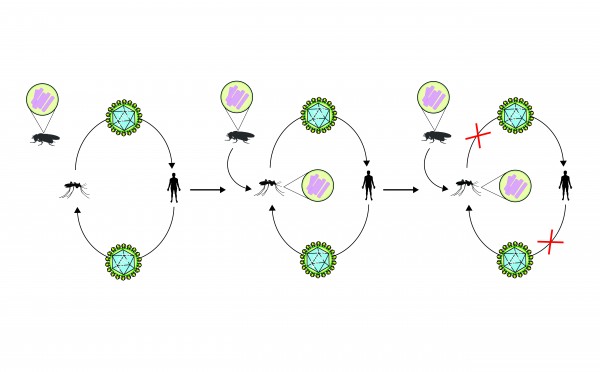A new study from Indiana University may explain how a bacterium called Wolbachia prevents mosquitoes from transmitting deadly diseases such as dengue fever, West Nile virus and Zika.
Study published in the PLOS Pathogens, is one of the first to identify a specific biological mechanism that prevents mosquitoes infected with this bacterium from transmitting diseases to humans. It could also potentially open a path toward methods to block disease transmission without Wolbachia, an organism whose long-term effect on the environment is unknown.
The use of Wolbachia-infected mosquitoes to curtail the spread of human diseases - a method called "pathogen blocking" - has already been implemented in some parts of the world. This includes the recent release of these mosquitoes in Florida to block the spread of Zika.
The spread of other insect-borne diseases is also expected to rise significantly in North America over the next several decades due to environmental change, according to the Centers for Disease Control and Prevention. Other viruses whose transmission is blocked in Wolbachia-infected mosquitoes include chikungunya, yellow fever and West Nile.
Source: newswise.com
To explore the biological mechanisms behind pathogen blocking, Newton and colleagues designed a model system consisting of Wolbachia-infected fruit flies and the Sindbis virus, which is easier -- and safer -- to manipulate in the lab than infectious agents such as the Zika or West Nile viruses.
Based upon a comparison of Wolbachia-infected versus uninfected fruit flies, the scientists found that flies with the bacterium produced significantly higher levels of Mt2, a gene that encodes a type of enzyme known as a methyltransferase.
They then used genetic tools to create two types of fruit flies: one that lacked this enzyme and another that produced unusually high levels of it.
The flies without the enzyme lost their ability to "block" the transmission of the Sindbis virus after infection with Wolbachia. The flies that produced high levels of the enzyme were resistant to the Sindbis virus -- even if they weren't infected with Wolbachia.
Moreover, this protective effect likely applies to the transmission of other deadlier viruses, not only the Sindbis virus. The lack of genetic similarities between viruses blocked by Wolbachia suggests that the bacterium blocks viruses through effects on the host.
There are a number of reasons scientists are interested in pursuing methods of pathogen-blocking without Wolbachia, Newton added. The widespread release of Wolbachia-infected mosquitoes could potentially trigger the rise of viruses resistant to the bacteria, for example.
There is also a lack of large-scale epidemiological studies to scientifically determine whether pathogen-blocking actually prevents outbreaks.
